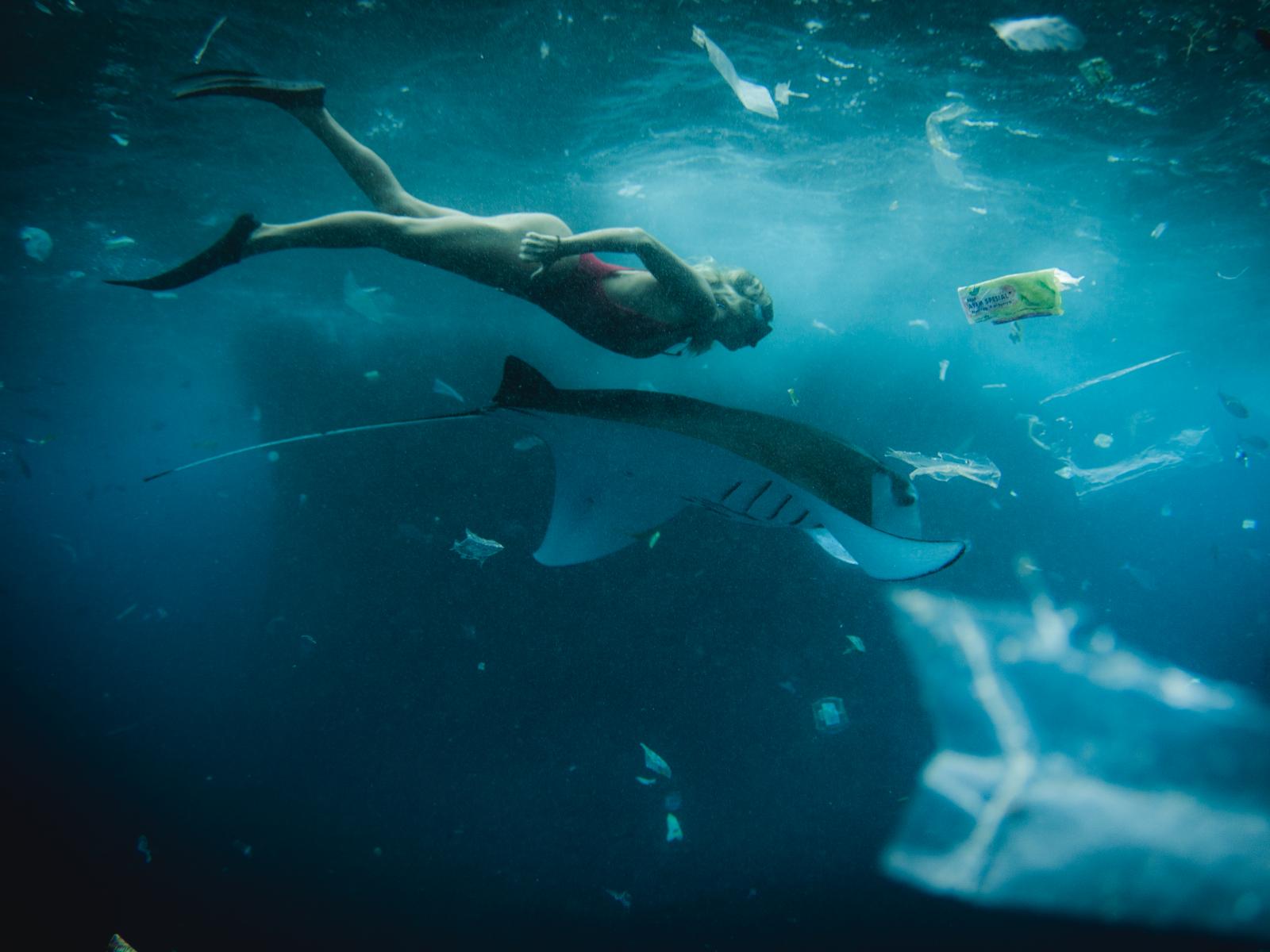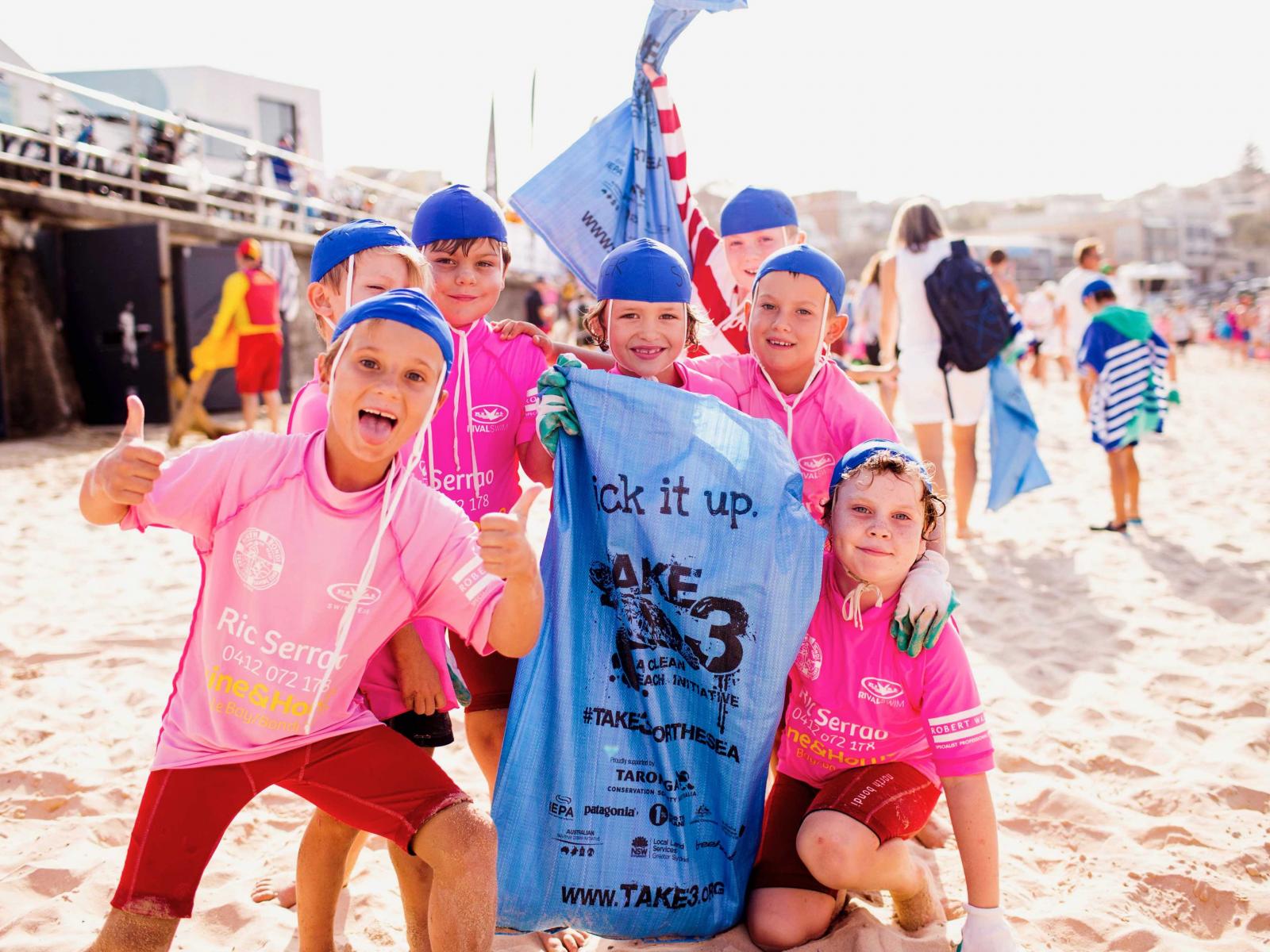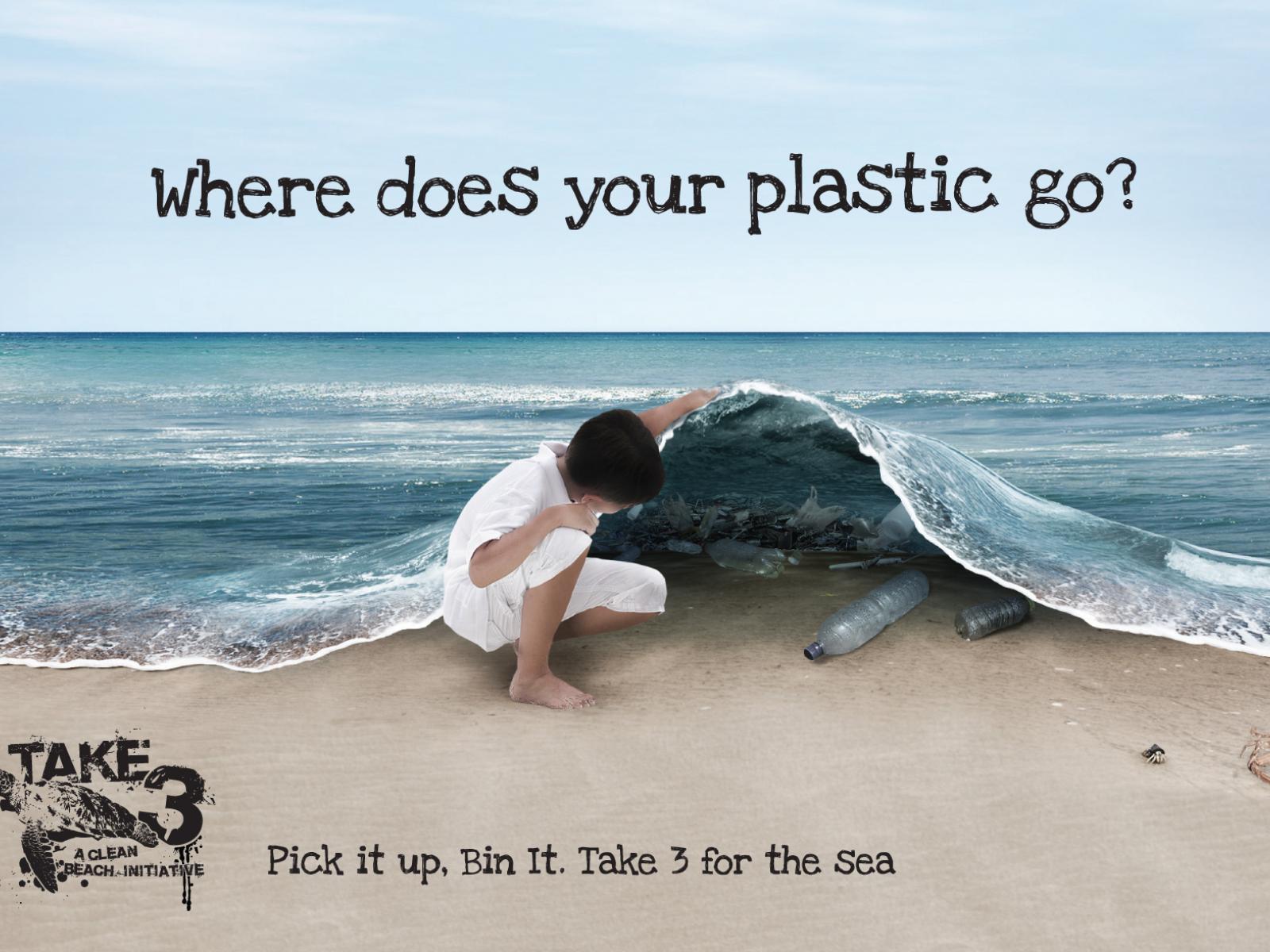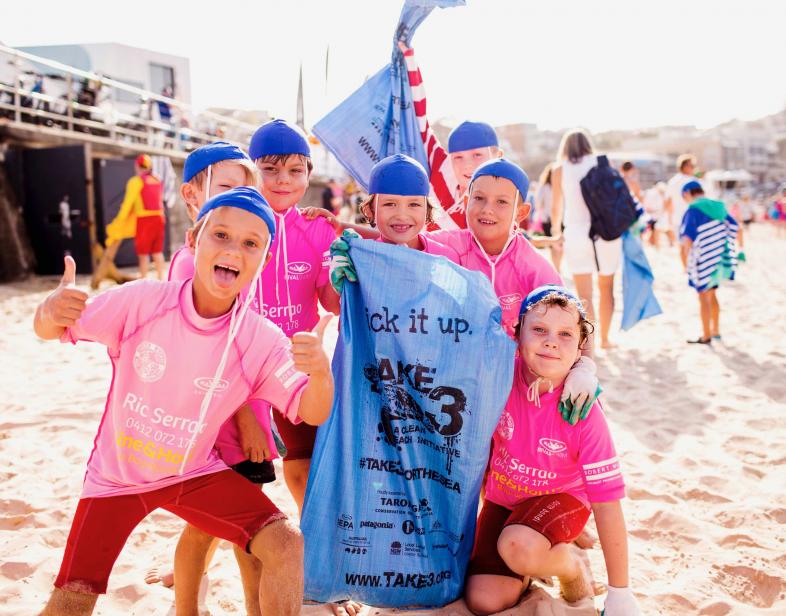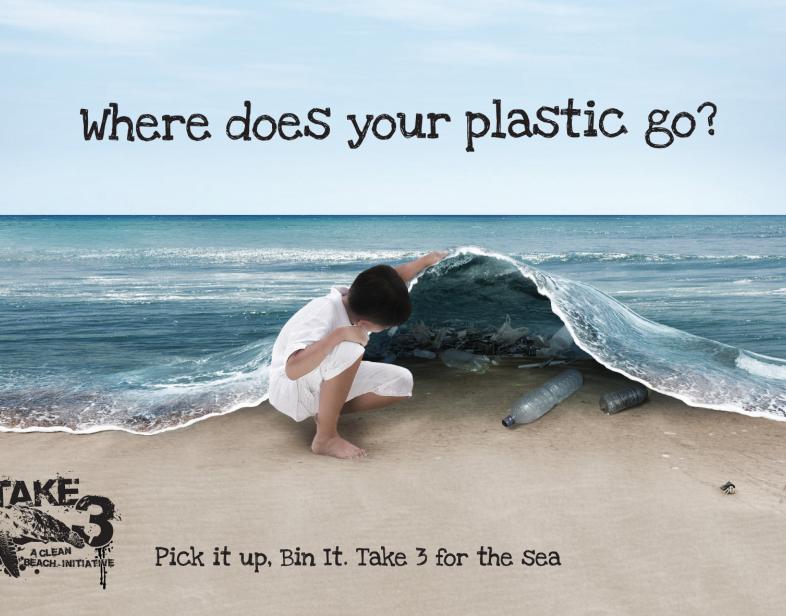An Overview Of Our Solution
Take 3’s mission is to significantly reduce global plastic pollution through education and participation.
We live in a world addicted to plastic. In 1950 the world’s produced 1.5 million tons of plastic; in 2016 we produced over 320 million tons of plastic. This is set to double by 2034.
The carbon footprint of plastic is significant. Production of 1kg of polyethylene requires the equivalent of 2kg of oil for energy and raw material and approximately 6 kg of CO2 is created per kg of plastic.
It is imperative we reduce our global plastic consumption to reduce the impacts of climate change on our environment. Take 3 delivers education programs and uses social media to inspire people across the globe to take action to reduce plastic pollution and transition to a circular economy.
- Population Impacted: In excess of 200,000
- Continent: Oceania
Context Analysis
Unless we act, by 2050 there will be more plastic in the ocean than fish causing irreversible damage to our ocean and threatening the projected world’s population of 9.7 billion. 6% of world-wide oil consumption is used for the production of plastic and 91% is not recycled.
The USA along with China and South East Asian countries all rank in top 20 countries by mass of mismanaged plastic waste entering the ocean. Over 275 million metric tonnes of waste is generated in 192 coastal countries and 8 million tonnes of plastic enter the ocean each year. In America, 500 million plastic straws are used every day and 100 billion plastic bags every year. Over 75% of what is removed from our beaches is made of plastic and originated from land.
Awareness levels and environmental education systems vary greatly among cultures and countries, and it is often the most disadvantaged communities that are facing the greatest pressure from climate change and environmental pollution.
Describe the technical solution you wanted the target audience to adopt
Assessing plastic pollution loadings, identifying litter hotspots, increasing participation, educating the public and measuring climate change offsets can be as simple as engaging the public in the #take3forthesea action. Data gathered by our social media campaigns are an effective technical solution to identify the cumulative impact of Take 3 and associated change behaviours.
Information on littered items, location, date/period and collectors was gathered during the initial 3 months of the ‘Pick it up. Snap it. Share it’ pilot. Macquarie University analysed 1,605 images; of which 500 passed the full quality QA/QC, a further 472 were considered for the totals, and 633 were unusable. Over 26,369 litter items were collected from 1 January - 10 April 2017.
Further analysis of our social media impact reveals powerful insights: people remove ~ 15 littered items per #take3forthesea image and our global community is responsible for removal of over 2.5million littered items annually.
Type of intervention
Describe your behavioral intervention
Take 3 works to increase awareness of plastic pollution; inspire waste reduction and plastic minimisation initiatives; prevent plastic pollution at its source; remove (and correctly dispose of) plastic pollution if encountered; and transition to a circular economy.
A survey run through the Take 3 Instagram page has revealed three key behavioural changes adopted by individuals after they first encountered Take 3’s message:
1. Waste Reduction. Take 3’s followers were asked to what extent the Take 3 message has led to them reducing their waste and use of single-use plastic, to which 98.3% of followers indicated they had done so, with 55.1% indicating they had done so to a significant extent.
2. Sustainability. Take 3’s followers were asked if the Take 3 message had led them to becoming more engaged in broader sustainability issues such as overfishing, recycling or climate change to which 96.3% indicated it had, with 51.2% by a significant extent.
3. Sharing. Take 3’s followers were asked to what extent they shared the Take 3 message with others, with 97.7% indicating they did so and 63.8% of which indicating they did so by a significant extent.
Take 3’s message has created significant behavioural changes in the vast majority of its followers.
As needed, please explain the type of intervention in more detail
Emotional Appeals –utilise both rational and emotional arguments to convince our audience of the need for behavioral change e.g. students are taught the facts and figures of plastic marine pollution in addition to visual images of animals impacted by plastic to evoke a powerful emotional response.
Social Incentives – targeted initiatives to specific interest groups e.g. surfers through a partnership with the World Surf League, targeted Take 3 films, appointing respected Pro-Surfers as Take 3 Ambassadors, etc.
Choice Architecture – utilise the biases of target audiences to achieve behavioural change and reduce plastic consumption. E.g. if people use plastic straws for reasons of hygiene we advocate for sustainable alternatives.
Describe your implementation
Take 3 addresses the growing problem of plastic pollution entering our ocean, waterways and broader environment with our simple, empowering message: Take 3 pieces of rubbish with you when you leave the beach, waterway or…anywhere and you have made a difference.
Personal responsibility is at the heart of the Take 3 message. Personal responsibility for the reduction of plastic consumption and for the removal of plastic pollution. Take 3 is fundamentally an education campaign promoting action and participation; and Take 3 works directly with a broad range of stakeholders to increase awareness of plastic pollution; reduce waste; and prevent sources of pollution.
Take 3 has spent 9 years developing and delivering quality education programs to schools, universities, surf life saving clubs and communities around Australia and our direct education programs have educated over 200,000 school students/youth and over 100,000 community members since 2009. Take 3 currently has over 98,000 followers on Facebook and 70,000 on Instagram, with the #take3forthesea hashtag used over 65,000 times in 129 different countries.
The simplicity of the Take 3 message and the ease with which it is spread across social media and within social circles is key to its success. In addition to the direct removal of plastic pollution, research reveals some of the behavioural changes initiated by the Take 3 message are:
• participants reducing their use of waste and single-use plastics,
• engaging in broader sustainability issues and
• communicating the Take 3 message within their social circles.
Momentum is building. As the global community becomes increasingly aware of the threats to the environment and potentially our own future from plastic pollution people, especially of younger generations, are experiencing a genuine need to contribute to a solution within the individual’s capacity or cultural or geographic reach. Take 3 provides this opportunity.
External connections
Take 3 have partnered with a variety of stakeholders to develop and implement our solutions to global plastic pollution through program development/implementation, financial support and policy change.
Government
• NSW Government (NSW EPA, Environmental Trust - Office of Environment & Heritage)
• Local Land Services (with funding from Commonwealth Government Landcare Programme)
• Local Councils
Education Institutions
• Over 200 primary and secondary schools
• Macquarie University
• University of Newcastle
• NSW Department of Education
• Taronga Zoo
Private Sector Partnerships
• Joco Cups
• The Clean Collective
• Avid Property Group
• Tomra Australia
In-Kind Partnerships
• World Surf League
• Atlassian
• Facebook Australia
• Instagram Australia
• Organise Internet
• Bean Farm Studios
Not-for-Profit Partnerships
• Tangaroa Blue
• Australian Marine Debris Initiative (AMDI).
• Boomerange Alliance
• Clean Up Australia Day
• Responsible Cafes / Responsible Runners
• Over 20 Surf Life Saving Clubs
T3 Ambassadors
T3 partners with a number of high profile social influencers who are Ambassadors of the program such as Adrian Buchan (Pro Surfer), Harley Ingleby (Pro Surfer), Kai Otton (Pro Surfer), Belinda Baggs (Pro Surfer), Lily Pollard (Pro Body Boarder) and many more.
Who adopted the desired behaviors and to what degree?
Take 3 currently has over 98,000 followers on Facebook and 70,000 on Instagram. A recent survey of our community revealed that 98% report that they ‘Take 3’ and 35% do it daily. Three key behavioural changes are adopted by individuals after they first encountered Take 3’s message:
1. Waste Reduction. Take 3’s followers were asked to what extent the Take 3 message has led to them reducing their waste and use of single-use plastic, to which 98.3% of followers indicated they had done so, with 55.1% by a significant extent.
2. Sustainability. Take 3’s followers were asked if the Take 3 message had led them to becoming more engaged in broader sustainability issues such as overfishing, recycling or climate change to which 96.3% indicated it had, with 51.2% by a significant extent.
3. Sharing. Take 3’s followers were asked to what extent they shared the Take 3 message with others, with 97.7% indicating they did so and 63.8% of which indicating they did so by a significant extent.
How did you impact natural resource use and greenhouse gas emissions?
Plastic pollution is choking our oceans, poisoning our food/water supplies and wreaking havoc on ecosystems worldwide. Take 3 message has inspired participants to collect ~ 2,500,000 pieces of rubbish annually and recycle, reducing the greenhouse gases emitted by degrading plastics. Behavioural changes adopted by Take 3 participants can have far reaching consequences. For example, if the 98% of Take 3 participants who reduced single-use plastics reduced their annual plastic bag usage by 20%, approximately 2,941,136 fewer plastic bags would be used annually. Moreover, if the 98% of Take 3 participants who spread the message amongst their social circle resulted in two additional people reducing their plastic bag usage by 20%, an additional 5,822,432 fewer plastic bags used per year (removing approximately 1,164,486 kg of CO2). Using similar calculations, it is estimated the Take 3 message resulted in an annual reduction of 1,773,250 coffee cups and 13,000,000 kg less waste.
What were some of the resulting co-benefits?
Resulting co-benefits of Take 3 plastic removal/reduction messaging include:
• Community/Social – community building; communities working together to achieve shared goals, see recent example below from Turkey.
• Water/Food Security/Nutrition – less microplastics in our water and food.
• Biodiversity Conservation – healthier aquatic ecosystems and wildlife.
• Economic/Sustainable Development –awareness and influence in policy changes that reduce global plastic pollution. If 10% of the Take 3 followers who indicate they have become more engaged in sustainability issues contact a local business in attempt to enact change, then 8,160 businesses would be contacted. Take 3 participants have also reported being inspired to contact their local politicians to change legislation around single-use plastics, convince local bars to stop using plastic straws, local cafés to create discounts for reusable coffee cups and encourage businesses to make a stand on single-use plastics.
Sustainability
The scalability and economic sustainability of Take 3 online engagement are excellent. The major benefits of Take 3’s social media and online engagement approach are:
• it’s low-cost for Take 3 to operate, and
• the ease and immediacy of which messages are communicated to its online audience.
As Take 3’s audience grows, it becomes even more cost effective to service this online audience. However, it is imperative Take 3 continues to develop and evolve its online resources and marketing to its evolving target audience.
Take 3 are a registered charity funded from corporate and government grants, fees for service, donations, sponsorships, partnerships and merchandise.
Return on investment
Take 3 have achieved exceptional outreach on the issue of plastic pollution with minimal resources and annual operating expenses of less than $150,000. Take 3 has a small and dedicated team, who strive diligently to achieve outcomes on the issue of plastic pollution rather than personal profiteering. As Take 3 has been growing and evolving for nearly a decade, the initial outlay – in terms of volunteer time – was enormous. Take 3 seeks to encourage a small action to empower the individual, leading to small lifestyle changes that, when applied to Take 3’s large online audience, makes significant collective changes. While financial investment into Take 3 has been small, the interest achieved from this investment is enormous.
How could we successfully replicate this solution elsewhere?
Take 3 is highly replicable globally. The #take3forthesea hashtag has been used over 65,000 times in 129 different countries, reaching even Central Africa and mainland Europe. Of these followers, 98% report that they do Take 3; 35% do it daily. The Take 3 message has enabled its participants to collect a projected 2.5 mil pieces of rubbish around the world. A recent example of our international outreach:
"Hi there we live in İzmir Turkey and are saddened by the amount of rubbish especially plastic which people leave on the beaches here. This year my daughters were asked to complete a project for school. We saw your Facebook page and every day since we have been collecting rubbish from our beaches. We had to do this project for 20 days but have decided to continue it and we got our neighbors involved too!“
To effective expand our simple, proactive message globally, Take 3 require strategic partnerships including a significant investment in electronic infrastructure and technology.
